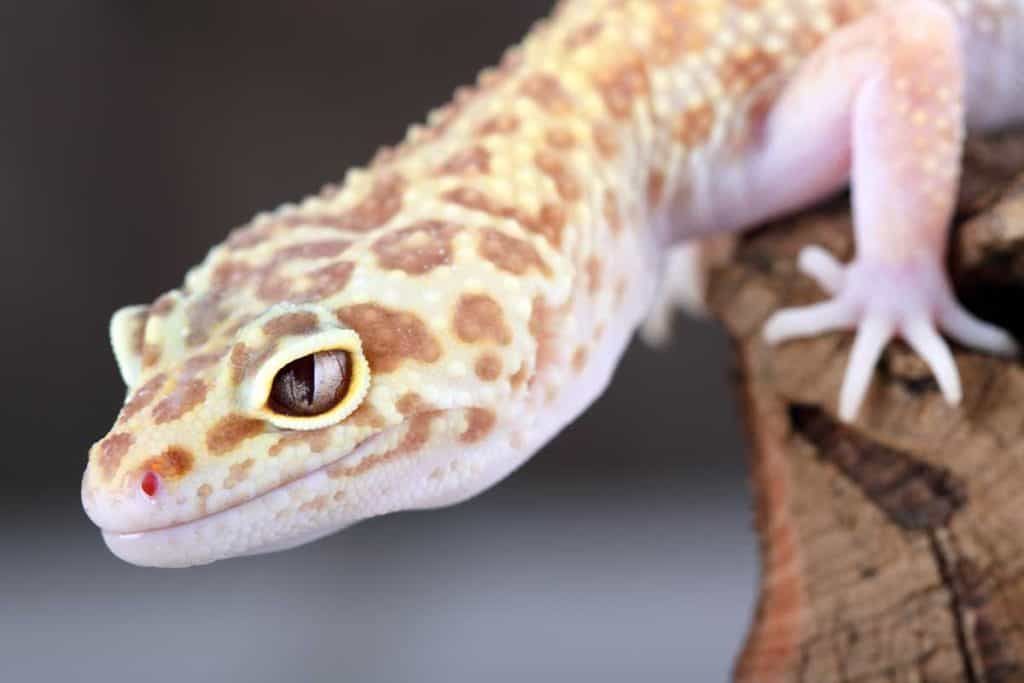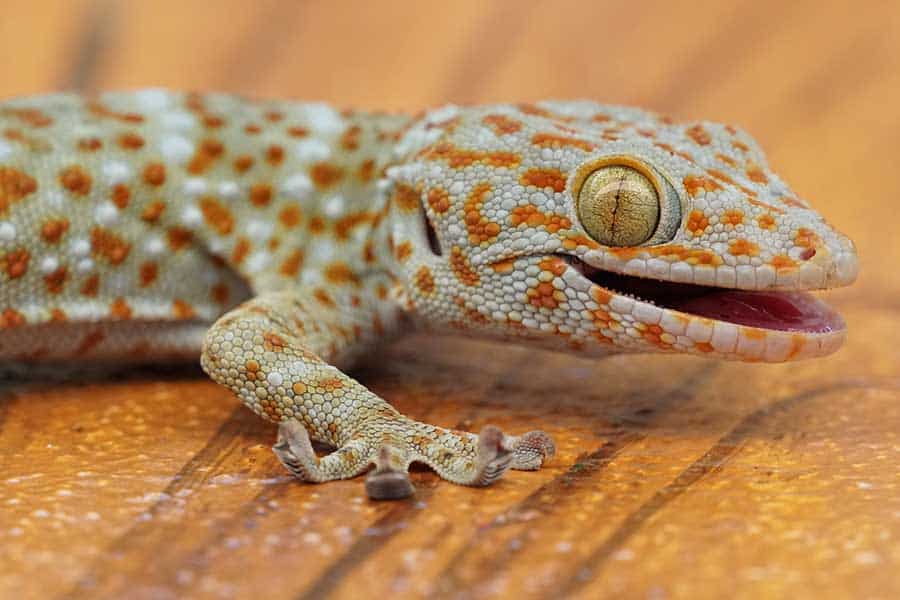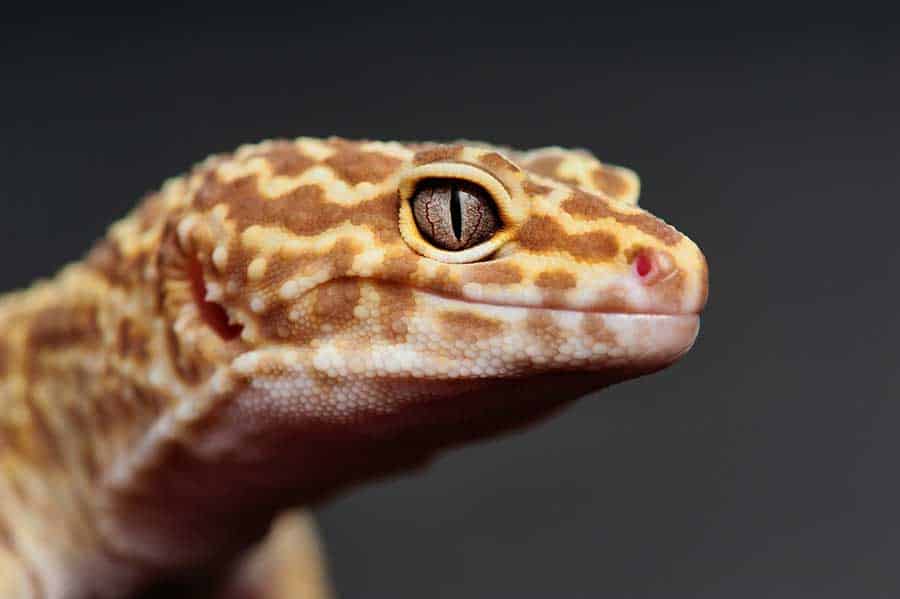Setting up a new enclosure for any reptile is stressful, especially because there are so many options out there. Enclosure setups are very specific and must be tailored to that animal to ensure its health. Creating the best leopard gecko setup is no different.
Every reptile enthusiast will have their own preferences, which is why we have provided a variety of options and adaptations where they are possible. However, there are some things that you cannot substitute or go for cheaper or smaller options because of their very specific nature.
When setting up a leopard gecko’s habitat, you need to consider its enclosure size and type, the lighting, humidity, temperature, substrate, and all of the things like hides and decor you are going to put in the enclosure.
Leopard geckos come from dry grasslands in Asia. This means their enclosures in captivity need to reflect this type of habitat in order for them to be healthy and comfortable. Fortunately, with this guide, you’ll be able to tailor your gecko’s enclosure to suit them perfectly.
Basic Elements of a Leopard Gecko Setup
Here are the things that go into a leopard gecko habitat:
- Enclosure
- Substrate
- Lighting
- Humidity
- Temperature
- Decor
Continue reading and learn more about each one.
Enclosure
When picking the right enclosure for your leopard gecko, you need to consider a combination of affordability, the space you have available in your home, what looks the best to you, and what is best for the leopard gecko calling it home. Here are some factors to keep in mind when choosing an enclosure.
Size
The size of an enclosure is important. If the enclosure is too small, then your leopard gecko will be stressed out and not have enough room to move around, which can lead to a shortened lifespan.
If you are housing one leopard gecko, then the minimum size for an enclosure is 10 gallons; however, a 20 to 30 gallon enclosure would be best. For every leopard gecko you add to that enclosure, it needs to increase by at least 10 gallons.
When it comes to leopard geckos, it is not a good idea to cohabitate more than three geckos together, regardless of enclosure size. Additionally, you should never have more than one male in the same enclosure.
Your enclosure should also be longer than it is tall. Leopard geckos are not arboreal; this means they do not climb trees and thus do not need much vertical space.
Type
The type of enclosure is a personal choice. There are many different styles of enclosures on the market, all of which look great and can provide a great habitat for your gecko. Below are the main types of enclosures you have to choose from as well as their specific features.
Glass
Glass enclosures tend to be the most common for reptiles like leopard geckos. They are completely see-through, last a long time if you are careful with them, and are very easy to clean. The downside to glass enclosures is that they can break and they are quite expensive.
The Repti Zoo
Plastic
Plastic enclosures are another great option. These are more durable than glass, and they maintain their heat well. The downside to plastic is the fact that they scratch easily, and the scratches can breed bacteria, which can be difficult to fully sanitize.
The Exo Terra Large plastic
terrarium is a good choice if you’re considering a plastic enclosure. It is long and flat, so there is plenty of space for your leo to move around in. Its lid comes off completely, and it has a small feeding hatch.
The enclosure is somewhat small, though, so it’s best for baby geckos. Thankfully, if you want a slightly larger option, Exo Terra’s Faunarium comes in a medium size that will suit most adult geckos once yours outgrows their first enclosure.
Wood
Wooden enclosures are the cheapest option, and you can build them yourself for a complete custom job! They have a more natural feel to them, and they last a very long time. The biggest downside to them is that if wood gets wet, it will grow mold.
However, you can fix this by coating the wood in a waterproofing material that is not toxic to animals and will not release toxins into the enclosure over time. Additionally, leopard geckos thrive in quite dry environments, so moisture from high humidity won’t be an issue.
A great product for waterproofing is the Pond Armor Non Toxic Pond Shield Epoxy paint.
Substrate
Substrate is the stuff that goes in the bottom of the enclosure. The substrate you choose is very important. Leopard geckos are terrestrial, which means that they will spend most of their life walking directly on top of whatever substrate you choose.
However, not all substrates are the same! Some are safer and easier to clean than others, while some pose a risk of impaction or are just too rough for your gecko to walk on.
Good Substrates
There is no need to be fancy and get the most expensive substrate on the market – paper towel and butcher’s paper is perfectly fine! If you use paper or paper towels, though, you will need to change it out more regularly than other substrates.
Reptile carpet is another great choice. It is absorbent and reduces the smells from pees and poops, it cannot be eaten, and it is super easy to clean. The Zilla Reptile
Another great choice is some form of smooth stone such as large pieces of slate or ceramic tiles. If you opt for tile or stones, be extra careful to count the number of live insect feeders you put in the tank during meal times so there are none lurking in the crevices causing havoc and annoying your gecko in the middle of the night!
Substrates to Avoid
Never use sand or other loose substrates that have small, indigestible particles! Leos will swallow the sand or other small pieces accidentally while they are eating. This will cause an impaction in their gut, which can be fatal.
Bark, walnut shells, wood chips, and other ‘organic’
Lighting
Leopard geckos are crepuscular lizards. This means they do not naturally run about in full daylight; they are typically most active during and between the hours of dawn and dusk. Their enclosure should mimic their natural lighting requirements.
A soft, low-powered light can be included in their enclosure during the day to mimic natural daylight. It is not essential to provide full-spectrum UVB lighting for your leopard gecko because they are not naturally in the sun during the day, but they do still benefit from a small amount of UVB rays.
If you do choose to use full-spectrum lighting, make sure it is low-wattage and that it turns on at dawn and off at dusk.
It is essential to provide your leo with a proper photocycle of light and dark; this means the lights should be on for 12 hours and off for 12 hours. Additionally, it’s best to avoid using red, blue, or other colored lights in their enclosure. These lights are very harsh on your gecko’s eyes, and they can cause severe stress if they interfere with your gecko’s daily photocycle.
Humidity
Leopard geckos are native to very dry environments and thus do not need high humidity in captivity, either. 30% to 40% humidity is ideal. Your gecko’s tank should not get additional moisture to it through misting. In addition, their water bowls should not be placed directly under lights, as the evaporating water will encourage the humidity to rise significantly.
If the humidity in your gecko’s enclosure becomes too high, it can cause respiratory illnesses. There should never be droplets of water on the enclosure’s walls.
However, leopard geckos do need a humid hide in their enclosure. They need a boost in humidity when it comes to shedding time. If they do not have that boost in humidity, their skin can become constricted around their tail and toes, resulting in “stuck shed,” which is painful and can cause your gecko’s toes or tail tip to fall off!
Creating a humid hide is simple. Take a hide (any opaque plastic container, half a coconut shell, or a small cave) and coat the inside with sphagnum moss, peat moss, or ecoearth. Keep this substance moist by misting the inside of it every couple of days.
Place the humid hide at the midpoint in the temperature gradient in the enclosure. This is to ensure the hide is not too cold and also that the moisture does not evaporate quickly and increase the overall humidity of the enclosure.
Temperature
Every leopard gecko enclosure needs to have a suitable temperature gradient. This is so your leopard gecko can move to different temperature ranges depending on what metabolic process they need to perform.
- Day time temperatures should be between 75°F and 85°F.
- Basking spot should be at 90°F.
- Nighttime temperatures should not fall below 70°F.
The temperature gradient can be created by placing a heat source at one end of the enclosure and adjusting it using a thermostat to create the correct temperatures. Heat sources can be lights, ceramic heat emitters, or heating pads.
A great heat emitter is the BOEESPAT Ceramic Heat Emitter. The great thing about this emitter is that it provides heat throughout the day and night without adding light. This means that your leopard gecko can have heat without getting their photocycle disturbed.
You should never use heated rocks or direct high-powered lighting, as the surface of the enclosure can become so hot that it can cause blisters and burns.
Regardless of what kind of heat emitter or heat bulb you choose, the enclosure needs to have two thermometers in it (ideally, dual
thermometer /hygrometers so you can also measure the humidity levels). One should monitor the warm end of the enclosure, while the other should be set up to monitor the cool end. It is important to keep a careful eye on the temperatures and adjust your leopard gecko’s setup as needed.
Leopard geckos are ectothermic and rely on their external environment to control their own body temperatures. If their enclosure becomes too hot, the leo has nowhere to escape and can die very quickly.
Decorations
Leopard geckos are very active and love to run around. They are quite intelligent and need the mental stimulation that comes from an interesting environment.
Setting up their enclosure in an interesting way will help promote a healthy and interesting environment. It is important that the enclosure’s decorations resemble the leopard gecko’s natural environment.
- Rocks — Leopard geckos love to climb rocks, so including some rocks, stones, or little caves in the enclosure will provide them space to climb, keep them active, and improve their muscle attachments as they grow.
- Logs — Additionally, including some logs or branches in the enclosure will provide your leopard gecko with some more diverse climbing spaces. The wood is natural, looks great, and will also help keep your gecko active and healthy.
When you use rocks and logs in your enclosure, you need to make sure that they are smooth. If they are rough or have sharp, jagged textures or protrusions, they can catch and tear your leopard gecko’s soft, tender underbelly. Still, do not use rocks that are too smooth, as your leopard gecko cannot grip them.
Setting up your enclosure does not have to be very expensive. You can use stones and branches from your own backyard! However, you need to sanitize them properly.
If you do opt to use rocks and logs from your yard, be sure to boil them and then set them out in the sun until they are completely dry. This process will kill off any microorganisms and microbes that could possibly hurt your leopard gecko.
Hides
Part of the decorations in your enclosure need to be two hides: the humid hide mentioned earlier and a dry hide. Your leopard gecko needs a nice, dark place in their enclosure to go and relax as well as a humid area to facilitate proper shedding. The hides should be small enough so that your leopard gecko feels safe and comforted.
Whenever you place decorations in the enclosure, make sure they are secured to the walls or are stable so that they will not fall over. If they fall over while your leo is on or under them, then your leo could suffer injuries or even die.
FAQs About Leopard Gecko Enclosures
Does my leopard gecko need plants in their enclosure?
Leopard geckos do not need plants in their enclosures, though artificial plants are fine. Live plants increase the humidity in reptile enclosures. You can, however, add air plants to the enclosure to add some more decoration and a natural feel.
If you choose to use artificial plants, make sure they are non-toxic so they are safe if your leopard gecko ends up chewing on them.
When should I set up my enclosure?
You should set up your enclosure at least a week before your leopard gecko arrives. This will give you an opportunity to get all of the humidity, lighting, and temperature settings just right. This will also give you an opportunity to test anything out and replace things that are faulty.
Scurrying Off…
Leopard geckos are fascinating creatures that make wonderful pets. They are unique and rewarding pets, but they also have unique enclosure requirements. They deserve the best care that you can provide them.
Overall, the requirements for a leopard gecko habitat are simple. They are not high maintenance and are very forgiving when it comes to beginner errors. With this guide, you should be able to give them the perfect little home.






